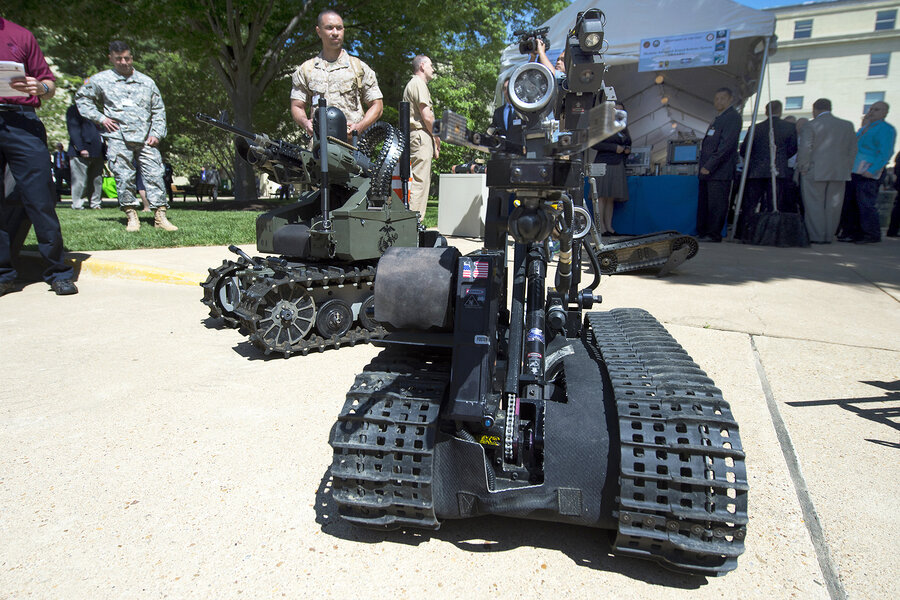From Batsuits to Magic Carpets, Pentagon shows off new toys
Loading...
| Washington
The Pentagon hosted its first-ever “lab day” this week, a rare chance to showcase 100 of the latest high-tech advances from more than 38,000 of the top scientists across the United States.
The goal of much of this revolutionary work is “to keep and maintain an unfair fight” for the US military, says Maj. Gen. Thomas Masiello, commander of the Air Force Research Laboratory.
In other words, the Pentagon likes to maintain the dominance of the US military in every possible way. These high-tech creations, Major General Masiello adds, “are game-changers.”
To this end, here are five of the most talked-about technologies around the Pentagon courtyard, where the creations were on display this week.
BATMAN suit
It’s a “Human-Machine interface” designed to be wearable high-tech gear for the battlefield. Coming from the military, it’s also an acronym, of course: Battlefield Air Targeting Man-Aided kNowledge.
The goal was to make some equipment smaller and more useful, but not so small that troops experience the “Zoolander effect,” says Michael Sedillo, an expert on the BATMAN project, referring to the film character’s phone that was so super-tiny that it was unusable.
“When you’re out in the field, and your hand’s shaking because you’re in the middle of a battle, that’s not what you need,” he says. Instead, the team goes for function, weaving LED lights into the fingers of gloves, for example.
The team is also working on the possibility of “e-textiles.” “What if we wove fiber-optics into your clothing?” Mr. Sedillo asks. You could aim a device at a vest to send vital battlefield information. “Then, boom, you’ve got it.”
'Magic Carpet'
Landing a fighter jet on the deck of an aircraft carrier has long been some of the trickiest work in the military.
Now, the Navy has developed the “Magic Carpet,” a set of innovations that makes it easier for pilots to control the landing of the plane, which requires great skill and experience.
Navy officials say that since the technology has been in place, it has saved at least two expensive F-16 fighter jets from crashing (and, potentially, two lives in the process, Navy officials add).
"We had 100 percent reduction of our deviations on touchdown, because there's less workload, and because it's very predictable and intuitive," said Naval Air Systems Command engineer James Denham, describing the initial testing.
3D facial recognition binoculars
These high-tech binoculars can help Special Operations Forces, for example, scan a crowd in a town square and potentially identify a bad guy from a list of some half-a-million faces programmed into the system.
What’s more, it can do this from a distance of more than two football fields, which is also helpful for troops providing base protection in places like Afghanistan, for example. Eventually, the goal is for binoculars to work from a distance of 300-500 meters.
“The benefit is that the subject doesn’t need to be cooperative” to be identified, says Michael Richmond, the project lead. “It’s a covert tool.”
Richmond’s training in astrophysics came in handy in developing the system. “Whether you’re looking at stars or a person, optics are very important,” he says.
Directed energy weapons
The Air Force is well on its way to using lasers as weapons in place of traditional exploding munitions, working with the Pentagon’s futuristic arm, the Defense Advanced Research Projects Agency to develop “medium power” lasers for fighter jets.
The benefits of laser weapons are that they are highly accurate, says David Hardy, who laughs when asked for his quintessentially military title: director of the Directed Energy Directorate.
Want to stop a moving truck from a fighter jet? With a laser weapon, “You can decide which tire to shoot out,” Dr. Hardy says. “You don’t blow things up, you melt holes.” As a result, passengers riding shotgun, say, are less likely to be hurt.
“The military is all about functional defeat,” Hardy adds. “If you can do it with minimal collateral damage, we like that.”
Electronic carrier pigeons
Like high-tech ravens from Game of Thrones, these saucer-sized, “disposable drones” are designed to act as message deliverers or sensors, but be “as light as a paper airplane,” says Aaron Kahn, a flight controls engineer at the Naval Research Laboratory.
The micro air vehicle is known as the CICADA and is “the smallest, simplest, and lowest-cost air vehicle” around. They can stack flat in a tube of 50, made from what looks like a cardboard circuit board.
Each one carries pressure, temperature, and humidity sensors. It also includes a modem “for data exfiltration once emplaced” using, say, an existing cell-phone network. They can also act as acoustic sensors, to fly, land, and transmit data along roads “so you can tell if a car went by,” Kahn notes.
It flies on autopilot, so the best part is that getting them in place – and leaving them there once their work is done – doesn’t place troops in danger.





